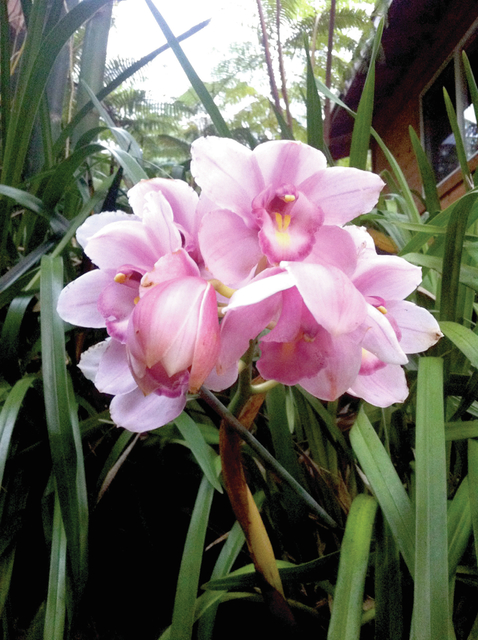Hilo Orchid Society is sponsoring a huge orchid show and sale June 3-5 at Edith Kanaka‘ole Stadium in Hilo.
However, it is more than orchids.
Growers of tropical Vireya rhododendrons, rare palms and epiphytes other than orchids will be there to give you ideas about how to make your Hawaiian garden more interesting and pleasurable. I wish I could be there, too, but we are now on the “Bigger Island” of Borneo exploring for rare palms with the International Palm Society.
•••
Since we live in a multicultural place with a great variety of climatic and geographic expressions, we can create almost anything in our gardens. Orchids, bromeliads and other epiphytes and lithophytes are perfect for gardens lacking what we consider “real” soil.
Most of our island is relatively young. Many folks live on rocky lava lands a few hundred years old or even younger. These rocky lands are composed of ‘a‘a or pahoehoe, with a little rotted organic matter in the wetter areas. Those folks lucky enough to live on cinder cones or cinder and ash deposits have soil of sorts, but it’s still lacking in all the nutrients necessary for optimum plant health.
In many other parts of the world, rock and water elements are used in the landscape to create a natural feeling and add interest to the design. Balinese gardens usually include not only naturalistic forms, but often, sculptured elements as well. In Japan, the stone water basins that stand outside the teahouses are an example of rock and water used on a small scale.
In almost any garden, the gentle sound and sight of water running over cool stones is refreshing.
Here on the Volcano Island, we have fantastic rock formations with which to work, and we have sufficient water to create outstanding landscapes. Many of the newer developments in west Hawaii such as Kukio, Hualalai, Waikoloa and Mauna Lani resorts are using the rough and rugged lava fields as an element with which to contrast lush tropical vegetation.
Orchids add the frosting on the cake, so to speak.
•••
If you are considering incorporating rock and water elements into your landscape, there are several ways to expand your imagination.
Of course, you could take a trip to Bali or Japan, but a less expensive way would be to get together with other creative folks who have similar interests. Another way to get ideas is to check out the numerous books about the subject at local libraries and bookstores. Many private and public gardens use natural rock and water to create a peaceful effect.
Of course, there are numerous landscape architects and landscape contractors who can assist you as well.
Before you start to work, here are some tips to help you avoid mistakes.
A rock and water garden can be located in a sunny exposed area but shade is usually better. Sunny locations require plants that tolerate intense sun and even drought. Cool and shady locations allow for a greater selection of plant materials that fit a water garden setting.
If you live in an area where it rains for weeks at a time, you might want to select a sunny spot for your creation. There are always exceptions to the rule.
In selecting rock, avoid little piles. Use large boulder types where possible. Our native lava is beautiful, but can weigh several hundreds of pounds. It takes heavy equipment to move these types or lots of guys with muscles. You might be better off contacting a contractor who has the kind of equipment you need.
Placing rock takes a special talent, but if you are good at placing furniture just right, then you shouldn’t have too much trouble. Guys, if your wife is the one with the artistic eye and she has you moving the furniture back and fourth a dozen times before it is right, then watch out for her rock placing practices!
Place the rocks so there will be little nooks and crannies for planting orchids, bromeliads and succulents, as well as an interesting pattern for water flow.
•••
Pool construction need not be difficult or expensive with the new material available.
Obviously, you need a waterproof basin to hold the water. This can be constructed with concrete and wire mesh for a permanent pool or you can use a heavy polyethylene plastic for something less permanent.
I experimented with a small 8-by-15-foot pool using 10 mil plastic four layers thick. It is 20 years old and still holds water, fish and water plants with a minimum of care. The total cost of the pool was about $50.
To move water and create a cascade or flow, you will need a small circulating pump. A good one can be purchased for less than $200. Some folks just camouflage a garden hose and run water over the rock formation when they have company or are just in the mood.
•••
Once you have your water garden in order, consider growing water lilies and other interesting water plants. You can’t beat water lilies for adding a flare of brilliant color to garden ponds. They can even be grown in big tubs, pots or urns filled with water.
Tropical water lilies surpass our more common types for their spectacular flower size. The colors range from shades of blue and purple to unusual orange tints. You can grow day blooming types combined with night bloomers for 24-hour enjoyment.
Many other aquatics also can be grown. Lotus, papayrus, water lettuce and hyacinths all add to the enjoyment of a water garden.
To avoid mosquito problems, you should add mosquito-eating fish, a few frogs and toads and some bug-eating lizards.
Top your water element off with those orchids you recently bought, and before you know it you will have created your own little ecosystems to enjoy.
•••
Borneo is home to orangutans, as well as many orchids, Vireya rhododendrons and, of course, many rare and perhaps yet to be discovered palms.
I will try to write these weekly columns as we travel the jungles hundreds of miles in the next several weeks. Borneo is almost 300,000 square miles.
We will be traveling from the border of Brunei and Sabah in the north, 800 kilometers to the border of Kalimantan near the capital of Kuching in the south.
Many plants that have yet to be discovered would do very well in Hawaii. We are hoping to see that some of these will be brought in to botanical gardens before they are destroyed by timber cutting and plantation agriculture.
For further gardening information, contact the master gardeners at our local UH College of Tropical Agriculture offices in Hilo and Kona.
This information is supplied by the University of Hawaii College of Tropical Agriculture and Human Resources. For further information, contact the office near you.






